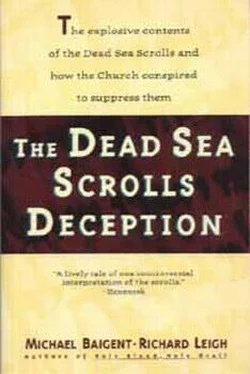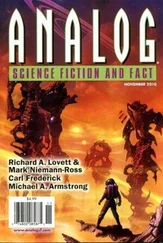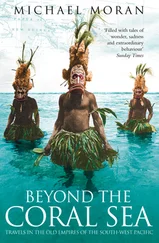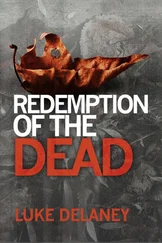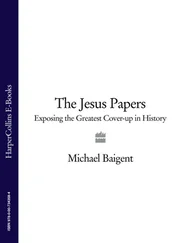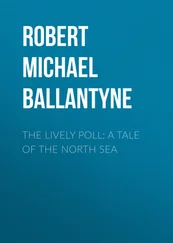In 1956, Edmund Wilson had favourably reviewed Allegro’s ‘popular’ book on the Dead Sea Scrolls. In 1969, when he brought out the new edition of his own book, it had swollen to twice its former length. The situation regarding the scrolls was no longer, for Wilson, merely a question of ‘tension’ and ‘inhibition’; it had now begun to assume the proportions of a cover-up and a scandal: ‘I have been told by a Catholic scholar that at first, in regard to the scrolls, a kind of official policy tended to bias scholarship in the direction of minimizing their importance.’ 51By the mid-1970s, biblical scholars were beginning to speak openly of a scandal. Even the most docile began to have their worries, and the international team were alienating men who had no desire to engage in academic controversy. Among the most prominent names in contemporary Semitic scholarship, for example, is that of Dr Geza Vermes, who has, since 1951, been publishing books and articles on the scrolls. Initially, he had no quarrel with the international team and their work. Like many others, however, he gradually began to lose patience with the delays in publication. In 1977, he published a book, The Dead Sea Scrolls: Qumran in Perspective, in the first chapter of which he publicly flung down the gauntlet:
On this thirtieth anniversary of their first coming to light the world is entitled to ask the authorities responsible for the publication of the Qumran scrolls… what they intend to do about this lamentable state of affairs. For unless drastic measures are taken at once, the greatest and the most valuable of all Hebrew and Aramaic manuscript discoveries is likely to become the academic scandal par excellence of the twentieth century. 52
True to form, the international team did not deign to take any notice. Nearly a decade later, in 1985, Dr. Vermes again called them to account, this time in the Times Literary Supplement:
Eight years ago I defined this situation as ‘a lamentable state of affairs’ and warned that it was ‘likely to become the academic scandal par excellence of the twentieth century’ unless drastic measures were taken at once. Regrettably, this has not happened and the present chief editor of the fragments has in the meantime gone on the record as one who rejects as unjust and unreasonable any criticism regarding the delay. 53
In the same statement, Dr Vermes praised Yigael Yadin, who had just died, for the promptitude with which he’d ushered into print the Qumran material in his possession: ‘But it is also a reminder to us all, especially to those who have been tardy in responding to the challenge of their privileged task, that time is running out.’ 54
In his desire to avoid undignified controversy, Dr. Vermes neglected to pursue the matter further. As before, the international team took no notice whatever of his comments. For Dr. Vermes, the situation must be particularly galling. He is a recognized expert in the field. He has published translations of such scrolls as have found their way into the public domain — through Israeli auspices, for example. He is certainly as competent to work on unpublished Qumran material as any member of the international team, and is probably better qualified than most. Yet for the whole of his distinguished academic career, access to that material has been denied him. He has not even been allowed to see it.
In the meantime, valuable evidence continues to remain under wraps. We ourselves can personally testify to vital material which, if it has not exactly been suppressed, has not been made public either. In November 1989, for example, Michael Baigent visited Jerusalem and met with members of the current international team. One of them was Father Emile Puech, the young ‘crown prince’ of the Ecole Biblique, who ‘inherited’ the scroll fragments previously assigned to Father Jean Starcky. These included material labelled ‘of unknown provenance’. In personal conversation, Father Puech divulged three important discoveries:
1. He had apparently found new overlaps between the scrolls and the Sermon on the Mount, including fresh and significant references to ‘the poor in spirit’. 55
2. In the Epistle of Barnabas, an apocryphal Christian text mentioned as early as the 2nd century ad, Puech had found a quotation hitherto untraced, attributed to an ‘unknown prophet’. The quotation, in fact, proved to have come directly from one of the Dead Sea Scrolls, thus establishing that the author of the Epistle of Barnabas was a member of, or had access to, the Qumran community and its teachings. Here was an incontrovertible link between Qumran and Christian tradition.
3. In the work of the 2nd-century Christian writer Justin Martyr, Puech found yet another quotation deriving directly from the Qumran scrolls.
‘We are not hiding anything,’ Puech insisted adamantly. ‘We will publish everything.’ 56To our knowledge, however, none of the revelations confided by Puech in conversation has yet appeared in print, and there seems no immediate likelihood of their doing so. On the other hand, there has been a recent ‘leak’ which offers some indication of the kind of material still being suppressed. This ‘leak’ surfaced in 1990, in the pages of BAR, and was confided, apparently, by an unnamed scholar whose conscience was troubling him. It consists of a Qumran fragment very similar to a passage in Luke’s Gospel. Referring to Jesus’ imminent birth, Luke (1:32-5) speaks of a child who will be called ‘Son of the Most High’ and ‘Son of God’. The Qumran fragment from Cave 4 also speaks of the coming of someone who ‘by his name shall… be hailed [as] the Son of God, and they shall call him ‘Son of the Most High’. 57This, as BAR points out, is an extraordinary discovery, ‘the first time that the term “Son of God” has been found in a Palestinian text outside the Bible’. 58Whatever the circumstances pertaining to the release of this fragment, it derives from the corpus of material hitherto controlled, and rigorously withheld, by the ‘elusive’ Father Milik.
4. Opposing the Consensus
Edmund Wilson, John Allegro and Geza Vermes all condemned the international team for secrecy, for procrastination and delay in releasing Qumran material and for establishing a scholarly monopoly over the Dead Sea Scrolls. Wilson and Allegro both challenged the team’s laboured attempts to distance the Qumran community from so-called ‘early Christianity’. In other respects, however, all three scholars concurred with the consensus of interpretation established by the international team. They accepted, for example, the team’s dating of the Dead Sea Scrolls as being pre-Christian. They also accepted the team’s contention that the members of the Qumran community were Essenes. And they accepted that the supposed Essenes at Qumran were of the traditional kind described by Pliny, Philo and Josephus — ascetic, reclusive, pacifist, divorced from the mainstream of social, political and religious thought. If Christianity were indeed somehow connected with the Qumran community, it therefore emerged as less original than had hitherto been believed. It could be seen to have drawn on Qumran, just as it was acknowledged to have drawn on ‘conventional’ Old Testament Judaism. Apart from that, there was no particular reason to modify one’s image or conception of it.
By the 1960s, however, scholarly opposition to the international team’s consensus had begun to arise from another quarter. Its questioning of that consensus was to be much more radical than anything submitted by Wilson, Allegro or Vermes. It was to challenge not only the dating of the Qumran scrolls as established by the international team, but also the allegedly Essene character of the Qumran community. The men responsible for this criticism were Cecil Roth and Godfrey Driver.
Читать дальше
